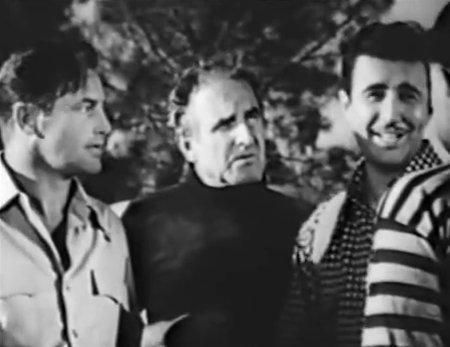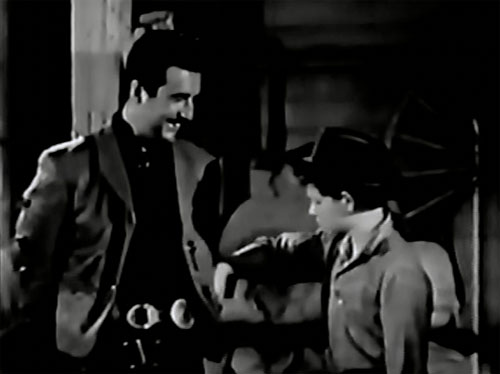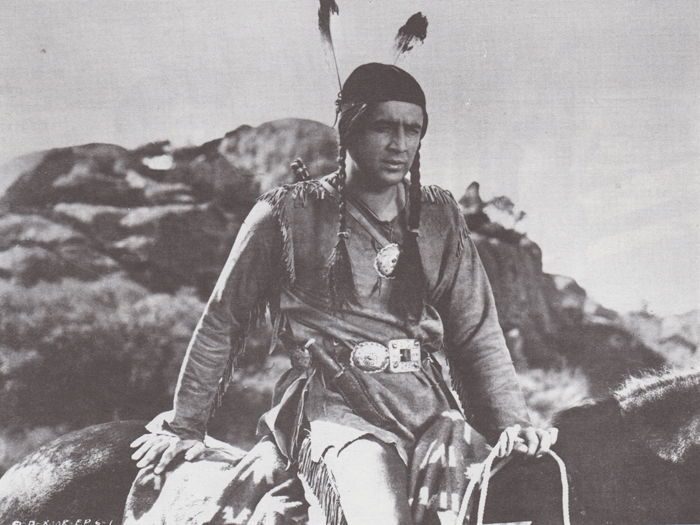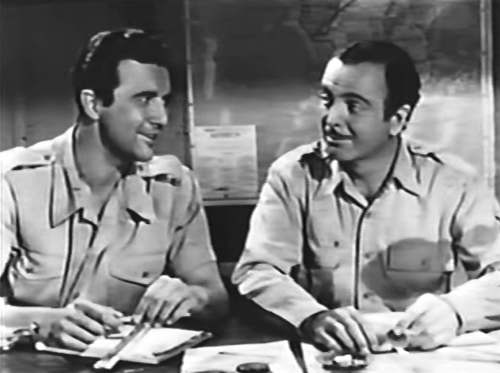September 24th, 1919 — August 31st, 1977

Above: A publicity still of Rick Vallin in the serial Batman and Robin (Columbia, 1949).
One of the most prolific members of producer Sam Katzman’s serial-making stock company during the years 1947 to 1955, Rick Vallin portrayed henchmen in several of his chapterplay outings–but was most frequently cast as the hero’s trusty aide. Unlike many other post-war portrayers of serial sidekicks, Vallin managed to make such assistant heroes seem like something more than simple, cipher-like extensions of the hero; his characterizations ranged from loudly breezy to quietly solemn, but were always individualized to some degree.
Rick Vallin was born Eric George Efron in Russia; his unaccented and thoroughly American-sounding voice would seem to indicate that he left Russia as a child, although he didn’t become an American citizen until 1944. His mother, a ballerina, probably influenced his early entrance into show business; he began working with New York stock companies in the middle of the 1930s, when he was still in his teens, and was appearing on Broadway by 1939. During the late 1930s and early 1940s, he also worked on the West Coast stage and played some movie bit parts; though he’d used his own name on Broadway, he had adopted the name of “Rick Vallin” by the time he received his first credited screen role–in the 1941 film Desperate Cargo, which was released by the Poverty Row studio PRC. During the first half of the 1940s, he would divide his acting time between stage work with the Pasadena Playhouse and screen appearances; most of the latter were in low-budgeted productions for PRC, Monogram, and various independent companies, although he did play occasional bits in A-features, a couple of sizable supporting roles in Republic’s more upscale B-Westerns, and a noticeable supporting part in a Columbia serial.
The serial in question was 1942’s Perils of the Royal Mounted, in which Vallin played a sympathetic Indian named Little Wolf–who, after having his life saved by RCMP Sergeant MacLane (Robert Kellard), helped the Mountie thwart an evil fur-trader (Kenneth MacDonald) who was out to foment an Indian war. Directed by James W. Horne, who made a habit of filling his serials with off-the-wall comic touches, Perils was a frustrating and unsatisfying combination of slapstick and seriousness, in which most of the actors (particularly star Kellard and the supporting villains) overacted to an absurd degree. Vallin’s character didn’t appear often enough in Perils to count as a full-fledged sidekick, but he still assisted the hero on a fairly regular basis; his dark complexion and angular features made him acceptable enough as a movie Indian, while his quiet but soberly alert performance–one of the few non-comic ones in the serial–provided welcome relief from Kellard’s continual shouting and the comic bumbling of the serial’s henchman group.

Above: Art Miles and Rick Vallin in Perils of the Royal Mounted (Columbia, 1942).
Stage work at the Pasadena Playhouse and a stint in the Coast Guard caused Vallin’s screen appearances to cease almost completely in 1945 and 1946; he didn’t start making movies on a regular basis again until 1947. In that year, he reestablished contact with Sam Katzman, who’d produced many of his Monogram B-films earlier in the 1940s, and was now ensconced at Columbia Pictures, supplying that studio with serials and various B-films. Beginning with Katzman’s feature The Last of the Redmen (Columbia, 1947), Vallin became a regular member of the producer’s Columbia stock company; his first Katzman serial was The Sea Hound (Columbia, 1947), in which he portrayed Manila Pete, one of the henchmen of a South Seas crime boss called the Admiral (Robert Barron). Vallin played this part with sullen toughness, and regularly participated in attacks on hero Buster Crabbe–but was continually required to take a back seat not only to Barron, but to Barron’s bodyguard Rusty Wescoatt, chief action heavy Jack Ingram, and rival villain Hugh Prosser; as a result, he was kept firmly in the background (and eventually got killed in almost offhanded fashion).

Above: Rick Vallin encourages a native cohort to swim out and cut the off-camera Buster Crabbe’s underwater air-line in The Sea Hound (Columbia, 1947), as Rusty Wescoatt keeps Crabbe’s boat in sight.
Vallin’s second Katzman serial, Brick Bradford (Columbia, 1948), gave him a much meatier role than Sea Hound had; indeed, though Bradford itself was an extremely uneven serial, far too low-budgeted for its ambitious science-fictional plot, it provided Vallin with the best acting showcase of his serial career. As “Sandy” Sanderson, the incurably flippant sidekick of adventurer Brick Bradford (Kane Richmond), he delivered a delightfully lively and tongue-in-cheek performance, continually cracking jokes and making drolly deadpan faces as his character took part in fantastic trips to the Moon and into the distant past; his performance did much to make the serial’s routine, slow-moving, and poorly-realized plot bearable. Vallin’s antics during the time-travel sequence were particularly entertaining; the cheerily careless way in which he flirted with a native girl, confused 18th-century pirates with modern slang, and made quips even when about to be burned at the stake, was decidedly reminiscent of Bob Hope’s behavior in that comedian’s Road movies.

Above: “Taxi!” Rick Vallin makes a deliberately absurd hail as Kane Richmond regains his bearings after their joint landing on an eighteenth-century desert island in Brick Bradford (Columbia, 1948).

Above: “You might call that a Twentieth Century gag; I guess it seems pretty strange to you Eighteenth Century guys…” Rick Vallin explains his successful hoodwinking of some hostile natives in Brick Bradford, alarming Kane Richmond and baffling Al Ferguson (center) and Frank Ellis (back to camera) with his careless time-traveler’s banter.
The chapterplay Batman and Robin (Columbia, 1949) featured Vallin as radio reporter Barry Brown, who continually leaked important information over the airwaves, frequently benefiting the master criminal known as the Wizard and frequently annoying Batman (Robert Lowery) and Commissioner Gordon (Lyle Talbot), who strongly suspected Brown of being the Wizard himself. However, the blabber-mouthed broadcaster was eventually cleared, after being nearly choked to death by the real Wizard. Vallin did a good job of making this suspicious character distinctively irritating, playing Brown’s smugness and cockiness to the hilt as he glibly refused to reveal his informational sources to the authorities or knowingly delivered his tell-all broadcasts. Vallin’s last 1940s serial was Adventures of Sir Galahad (Columbia, 1949), an entertaining and unusual Arthurian adventure in which he received a fair share of screen time but almost no dialogue; as Sir Gawain, one of King Arthur’s (Nelson Leigh) loyal Knights of the Round Table, he regularly attended on the King in various battles, but rarely got to say anything, leaving the verbal unfolding of the plot to Arthur, Galahad (George Reeves), and other knights.

Above: Rick Vallin parries the questions of Lyle Talbot (seated) while Robert Lowery (in hat and tie) and John Duncan watch in Batman and Robin (Columbia, 1949).

Above: Rick Vallin’s Sir Gawain and another Knight of the Round Table face off with off-camera Saxon foemen in Adventures of Sir Galahad (Columbia, 1949).
The early years of the 1950s found Vallin still working steadily in Katzman’s features (particularly his Jungle Jim films and Arabian Nights pictures like The Thief of Damascus), occasionally playing bits and supporting parts for other studios like RKO and Universal, and making quite a few acting appearances on various radio shows. He also continued to appear regularly in Katzman’s serials; his first 1950s chapterplay was Cody of the Pony Express (Columbia, 1950), in which he played an outlaw named Denver and got some good opportunities to act slick and slimy before getting killed off in Chapter Four. He was particularly entertaining during a sequence in which he was captured by the good guys but managed to trick a naïve young boy into setting him free; he amusingly conveyed caginess, strained affability, and thinly-veiled annoyance as he parleyed with the youngster. His next serial, Atom Man vs. Superman (Columbia, 1950), gave him only one on-camera scene as a power-company lineman who opportunely showed up to rescue Lois Lane (Noel Neill) and Jimmy Olsen) in Chapter Nine, engaging some of Luthor’s (Lyle Talbot) thugs in a fistfight in the process; however, his voice was heard at several other points in the serial, as that of a radio broadcaster delivering news reports about Luthor’s various criminal activities.

Above: Rick Vallin allows Bobby Hyatt to take his watch in exchange for cutting him loose in Cody of the Pony Express (Columbia, 1950).

Above: Rick Vallin displays perplexity as Noel Neill and Tommy Bond excitedly tell him about Superman, Atom Man, the Empty Doom, and other odd-sounding aspects of the plot of Atom Man vs. Superman (Columbia, 1950).
Roar of the Iron Horse (Columbia, 1951), one of Katzman’s best serials, featured Vallin as White Eagle, an Indian whose tribe had been subjugated by a crooked rancher known as the “Baron,” (George Eldredge), and who assisted undercover lawman Jim Grant (Jock Mahoney) in his fight to protect a railroad construction project from both the Baron’s followers and another gang of outlaws. Vallin’s character here was much like his earlier friendly Indian in Perils of the Royal Mounted, making sporadic but notable appearances throughout Iron Horse and figuring as a sort of part-time sidekick; he adopted a halting and deliberate style of dialogue delivery that gave White Eagle an extremely grave air, but varied this solemnity with a convincing outburst of anger when confronting the Baron.

Above: Rick Vallin in a publicity still for Roar of the Iron Horse (Columbia, 1951).
The science-fiction serial Captain Video (Columbia, 1951) briefly featured Vallin in four of its episodes as Video Ranger Brown, one of the many uniformed operatives who battled scientific super-criminality on the orders of Captain Video (Judd Holdren); Vallin had little to do here but shadow suspects, intently deliver reports to Video, and (in one episode) drive up in time to rescue the Captain by zapping some thugs. He had a much meatier role in the jungle chapterplay King of the Congo (Columbia, 1952); playing a Communist agent named Andreov, he started this serial as a smugly confident villain, only to be wrongfully accused of treason by his Party superiors about a third of the way through the serial. Rescued from torture and death by hero Buster Crabbe, Vallin renounced villainy and joined the good guys’ side, serving as Crabbe’s loyal sidekick for the remainder of the serial and adopting a good-natured but grimly thoughtful manner that seemed very well-suited to a repentant villain; he also managed to bring some conviction to a couple of rather clunky-sounding speeches in praise of liberty and democracy.

Above: Rick Vallin contacts Captain Video (Columbia, 1951) via radio.

Above: Rick Vallin praises the genius of his villainous boss Leonard Penn in King of the Congo (Columbia, 1952).

Above: Rick Vallin earnestly renounces his evil ex-associates as friendly natives Neyle Morrow (left) and William Fawcett watch in King of the Congo.
Vallin again played both a Communist and an anti-Communist in the serial Blackhawk (Columbia, 1952), which starred Kirk Alyn as the leader of an international squadron of paramilitary spy-fighters. As Stanislaus, the Polish member of the “Blackhawks,” Vallin was kidnapped by Laska’s (Carol Forman) Red espionage ring in Chapter One and replaced by his evil twin brother Boris, one of Laska’s agents; however, he soon escaped Laska’s gang to rejoin the other Blackhawks. The Boris/Stanislaus subplot occupied Blackhawk’s first three chapters, putting Vallin at the center of the action; though he joined fellow backup Blackhawks Don Harvey and Larry Stewart as an interchangeable background sidekick after the subplot was resolved, he made the most of his early moments in the spotlight. As Stanislaus, he resisted Laska’s impassioned attempts to corrupt him with somber sternness and faced up to her henchmen with sardonic humorousness, while as Boris he adopted a menacingly surly and aggressive demeanor.

Above: Zon Murray watches as Rick Vallin’s Stanislaus eagerly opens a letter from the “old country” in Blackhawk (Columbia, 1952).

Above: Rick Vallin’s Boris listens nervously as Laska (Carol Forman) reports his failure to her spy ring’s mysterious leader, while Marshall Reed eyes Vallin as if the latter has already been scheduled for liquidation in Blackhawk.
The well-done Western serial Son of Geronimo (Columbia, 1952) cast Vallin as an outlaw named Eadie, a member of the serial’s henchman pack; as in The Sea Hound, he was thrust into the background by several more prominent villains and quasi-villains–a slick lawyer (Marshall Reed), assorted higher-ranking outlaws (Zon Murray, John Crawford, and Sandy Sanders) and the titular Apache war-chief (Rodd Redwing); he only briefly became central to the plot in Chapter Ten, when he was captured by hero Clayton Moore, forcing the other heavies to try and rescue him before he could talk. Even in this episode, he received few lines, though he did get to engage in a ferocious fight with Moore before dying in a wagon crash at the end of the episode. After this minor serial role and one final turn in a Jungle Jim film (Voodoo Tiger), Vallin drifted away from Katzman’s Columbia outfit; he devoted most of the years 1953 to 1959 to television work, making innumerable TV appearances on shows ranging from The Gene Autry Show to Have Gun Will Travel; he also appeared in some features during this period (most notably several of Allied Artists’ Western films), but had become almost exclusively a television actor by the end of the 1950s.

Above: Rick Vallin (still wearing a cavalryman disguise, used in a trouble-stirring raid on the Indians) looks furtive as Clayton Moore (center) tells Bud Osborne what Vallin and his associates have been up to Son of Geronimo (Columbia, 1952).
Vallin did find time to do three more serials for Katzman during the 1950s–although it’s doubtful that any of them interfered very much with his busy TV-acting schedule; all three were patchwork affairs that derived at least three-quarters of their footage from earlier serials. The first of these warmed-over chapterplays, Riding With Buffalo Bill (Columbia, 1954) featured Vallin as as “Reb” Morgan, an embittered ex-Confederate drifter who initially threw in with some outlaws, but turned against them when they threatened his sister, becoming the serial’s co-hero and allying with principal hero Bill Cody (Marshall Reed) to destroy the outlaw band. Affecting a noticeable but not overdone Southern accent, Vallin delivered a solid and interesting performance in Bill’s few original scenes, giving his character a properly bitter and moody air without making him seem entirely unsympathetic–and thus making it easy to believe in his switch to cheerful heroism in the middle of Chapter Three; however, after Morgan’s reformation was complete, Vallin–like his co-star Reed–was almost completely relegated to serving as a bridge to protracted stock-footage sequences from the 1940s Columbia serials Deadwood Dick and The Valley of Vanishing Men.

Above: Rick Vallin ponders ways of making his fortune as Shirley Whitney keeps a wary eye on him in Riding With Buffalo Bill (Columbia, 1954).
Adventures of Captain Africa (Columbia, 1955), arguably Columbia’s worst serial, again featured Vallin as co-hero, and again used him chiefly as a link between stock-footage sequences. His character, Ted Arnold, was an undercover UN agent who joined with mysterious jungle avenger Captain Africa (John Hart) to fight spies and usurpers in the jungle and in a desert kingdom; this duo’s adventures provided a weak thread on which to hang borrowed action scenes from three very disparate Columbia serials: Jungle Menace, The Phantom, and The Desert Hawk. The last-named chapterplay, an Arabian Nights outing starring Gilbert Roland, provided the majority of the stock; Vallin, wearing a moustache and a pair of thickened eyebrows that gave him a startlingly strong resemblance to Roland, served as the chief link to the Hawk footage, and thus actually received more screen time than the top-billed Hart did (although neither of them were actually on-screen for that long). No actor could have made Africa anything more than a mess, but Vallin did at least handle his character’s standardly heroic lines with cheerfulness and self-assurance.

Above: Rick Vallin slugs an Arab heavy towards the camera during a fight scene in Adventures of Captain Africa (Columbia, 1955).
Before appearing in his third and final patchwork serial for Katzman, Vallin made his first and only non-Columbia serial, King of the Carnival (1955). Republic Pictures’ last chapterplay and one of their weakest, Carnival at least had better production values than Vallin’s two previous serials, although his own role was less prominent; he was cast as US Treasury agent Art Kerr, who discovered a connection between a counterfeiting ring and a traveling circus, and recruited his old war buddy Bert King (Harry Lauter)–now a circus acrobat–to investigate this connection more thoroughly. After setting up the serial’s basic plot in the opening chapter, Vallin spent most of his time merely radioing orders to Lauter or receiving reports from him, but did directly re-enter the investigation on occasion; he played his part with a suitable combination of official briskness and down-to-earth affability, interacting with Lauter in an easygoing and good-natured way that made it easy to believe that their characters were old comrades.

Above: Rick Vallin has just caught carnival barker Mauritz Hugo passing funny money in King of the Carnival (Republic, 1955).
Vallin’s last serial was Perils of the Wilderness (Columbia, 1956), Katzman’s penultimate chapterplay production. A jarring and frequently ludicrous combination of stock footage from Columbia’s second serial (The Mysterious Pilot) and Vallin’s first serial (Perils of the Royal Mounted), this outing did at least bring Vallin’s cliffhanging career full circle, since it allowed him to virtually reprise his initial serial role. He was cast as an Indian named Little Bear, who filled almost exactly the same plot function as Vallin’s Little Wolf in Perils of the Royal Mounted, helping heroes Dennis Moore and Richard Emory fight villains who were trying to manipulate the Indians; in fact, several of Vallin’s scenes from the earlier serial were reused wholesale in Wilderness. Vallin, like most of the other actors in this last-gasp serial, did little more than go through the motions of his role–mouthing his broken-English dialogue with grave professionalism, but frequently coming off as more glumly embarrassed than anything else.

Above: Rick Vallin and Robert Bice in Perils of the Wilderness (Columbia, 1956).
As aforementioned, Vallin remained active as a television player until the end of the 1950s; his film appearances became much more scattered during the early 1960s, and by the middle of that decade he had retired from acting–at least from screen acting; he could conceivably have continued to do stage and radio work for several years thereafter. He was still living in the Hollywood area when he passed away in 1977.
Though he lacked the larger-than-life screen presence of Buster Crabbe, Jock Mahoney, and some of the other leading men he supported, Rick Vallin was no bland nonentity; a thoroughly capable actor, he was nearly always able to impart some genuine personality to secondary roles that he could just as easily have sleepwalked through. The best that can be said of many of Vallin’s serial-sidekick contemporaries–lackluster players such as House Peters Jr., James Dale, or Larry Stewart–is that they didn’t actively damage the chapterplays they appeared in; Vallin, on the other hand, actively enhanced most of his chapterplay vehicles.

Above: Rick Vallin flashes a rascally grin in Brick Bradford (Columbia, 1948).
Acknowledgements: The biographical information in this piece was derived from three principal sources: Boyd Magers’ online Serial Report article on Vallin (which includes some quotes from Vallin’s co-star and friend John Hart), Gary Brumburgh’s Internet Movie Database biography of Vallin, and a short biographical blurb on Vallin within this overview of Sam Katzman’s film Jungle Jim, on the excellent Johnny Weissmuller website. Vallin’s 1944 naturalization form and an Internet Broadway Database cast listing were also very useful to me.